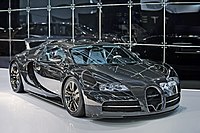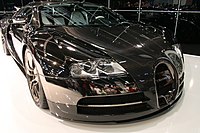Bugatti Veyron
| Bugatti Veyron 16.4 | |
|---|---|
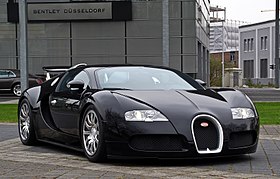 | |
| Overview | |
| Manufacturer | Bugatti Automobiles S.A.S. |
| Production |
|
| Assembly | France: Alsace, Molsheim[1] |
| Designer | Jozef Kabaň[2] |
| Body and chassis | |
| Class | Sports car (S) |
| Body style | |
| Layout | Mid-engine, all-wheel drive |
| Related |
|
| Powertrain | |
| Engine | 8.0 L (488 cu in) quad-turbocharged Volkswagen WR16 |
| Power output | |
| Transmission | 7-speed Ricardo dual-clutch automatic |
| Dimensions | |
| Wheelbase | 2,710 mm (106.7 in) |
| Length | 4,462 mm (175.7 in) |
| Width | 1,998 mm (78.7 in) |
| Height | 1,204 mm (47.4 in) |
| Kerb weight | 1,838–1,990 kg (4,052–4,387 lb) |
| Chronology | |
| Predecessor | Bugatti EB 110 |
| Successor | Bugatti Chiron |
The Bugatti Veyron EB 16.4 is a mid-engine sports car, designed and developed in Germany by the Volkswagen Group and Bugatti and manufactured in Molsheim, France, by French automobile manufacturer Bugatti. It was named after the racing driver Pierre Veyron.
The original version has a top speed of 407 km/h (253 mph).[5][6] It was named the 2000s Car of the Decade by the BBC television programme Top Gear. The standard Veyron also won Top Gear's Best Car Driven All Year award in 2005.
The Super Sport version of the Veyron is one of the fastest street-legal production cars in the world, with a top speed of 431.072 km/h (267.856 mph).[7] The Veyron Grand Sport Vitesse was the fastest roadster in the world, reaching an averaged top speed of 408.84 km/h (254.04 mph) in a test on 6 April 2013.[8][9] The Record for world's fastest production car was later taken by another Bugatti, the Chiron, and then often changed hands for a while.[10]
The Veyron's chief designer was Hartmut Warkuß, with the exterior being designed by Jozef Kabaň of Volkswagen. Much of the engineering work was conducted under the guidance of chief technical officer Wolfgang Schreiber. The Veyron includes a sound system designed and built by Burmester Audiosysteme.[11]
Several special variants have been produced. In December 2010, Bugatti began offering prospective buyers the ability to customise exterior and interior colours by using the Veyron 16.4 Configurator application on the marque's official website.[12][13] The Bugatti Veyron was discontinued in late 2014, but special edition models continued to be produced until 2015.
Origins
In May 1998, Volkswagen AG acquired the rights to use the Bugatti logo and the trade name Bugatti Automobiles S.A.S. To succeed the EB 110 model produced under the previous ownership, the automaker quickly released a series of concept cars whose technological advancements would culminate in the form of the Veyron 16.4.
Between October 1998 and September 1999, Bugatti introduced a series of Giugiaro-designed concept vehicles, each with permanent four-wheel drive and powered by the Volkswagen-designed W18 engine. The first car, the EB 118, was a 2-door luxury coupé presented at the 1998 Paris Motor Show. The next car, the EB 218, was a 4-door saloon presented at the 1999 Geneva Motor Show. The third and final car, the 18/3 Chiron, was a mid-engine sports car presented at the 1999 International Motor Show in Frankfurt.[14]
In October 1999, Bugatti unveiled a fourth concept car at the Tokyo Motor Show. The EB 18/4 Veyron was a mid-engine sports car styled in-house under the direction of Hartmut Warkuß.[15] In 2000, a modified version, the EB 16/4 Veyron, was displayed at motor shows in Detroit, Geneva, and Paris. Rather than the three-bank W18 engine of the four previous concept cars, the EB 16/4 featured the four-bank WR16 engine architecture installed in every production example of the Veyron.[16] Warkuß also commissioned SEAT head of design, Walter de Silva, to submit a design proposal for the new Bugatti. The design was ultimately rejected in favour of Warkuß's own proposal.[17]
The decision to start production of the car was made by the Volkswagen Group in 2001. The first roadworthy prototype was completed in August 2003. It is identical to the later series variant, except for a few details. In the transition from development to series production, considerable technical problems had to be addressed, repeatedly delaying production until September 2005.[18]
The Veyron EB 16.4 is named in honor of Pierre Veyron, a Bugatti development engineer, test driver and company race driver who, with co-driver Jean-Pierre Wimille, won the 1939 24 Hours of Le Mans while driving a Bugatti.[19] The "EB" refers to Bugatti founder Ettore Bugatti and the "16.4" refers to the engine's 16 cylinders and quad-turbochargers.[20]
Bugatti Veyron (2005–2011)
Specifications and performance

The Veyron features an 8.0-litre, quad-turbocharged, W16 cylinder engine, equivalent to two narrow-angle V8 engines bolted together. Each cylinder has four valves for a total of 64, but the configuration of each bank allows two overhead camshafts to drive two banks of cylinders so only four camshafts are needed. The engine is fed by four turbochargers and displaces 7,993 cc (487.8 cu in), with a square 86 by 86 mm (3.39 by 3.39 in) bore and stroke.


The transmission is a dual-clutch direct-shift computer-controlled automatic transmission having seven gear ratios, with magnesium paddles behind the steering wheel and a shift time of less than 150 milliseconds, built by Ricardo of England rather than Borg-Warner, who designed the six speed DSG used in the mainstream Volkswagen Group marques. The Veyron can be driven in either semi-automatic or fully-automatic mode. A replacement transmission for the Veyron costs just over US$120,000.[21] It also has permanent all-wheel drive using the Haldex Traction system. It uses special Michelin PAX run-flat tyres, designed specifically to accommodate the Veyron's top speed, and cost US$25,000 per set.[21] The tyres can be mounted on the wheels only in France, a service which costs US$70,000.[21] Kerb weight is 1,888 kg (4,162 lb).[22] This gives the car a power-to-weight ratio, according to Volkswagen Group's figures, of 530 PS (390 kW; 523 hp) per ton. The car's wheelbase is 2,710 mm (106.7 in). Overall length is 4,462 mm (175.7 in) which gives 1,752.6 mm (69.0 in) of overhang. The width is 1,998 mm (78.7 in) and height 1,204 mm (47.4 in). The Bugatti Veyron has a total of ten radiators:[23]
- 3 heat exchangers for the air-to-liquid intercoolers.
- 3 engine radiators.
- 1 for the air conditioning system.
- 1 transmission oil radiator.
- 1 differential oil radiator.
- 1 engine oil radiator
It has a drag coefficient of Cd=0.41 (normal condition) and Cd=0.36 (after lowering to the ground),[24] and a frontal area of 2.07 m2 (22.3 sq ft).[25] This gives it a drag area, the product of drag coefficient and frontal area, of CdA=0.74 m2 (8.0 sq ft).
Engine power output
According to Volkswagen Group and certified by TÜV Süddeutschland, the W16 engine utilised by the Veyron has a power output of 736 kW (987 hp; 1,001 PS), and generates 1,250 N⋅m (922 lbf⋅ft) of torque.[26][27][28] The Bugatti Veyron finally had a confirmed horsepower output of 1001, mainly so Volkswagen could say their car has over 1000 horsepower.
Top speed
German inspection officials recorded an average top speed of the original version at 408.47 km/h (253.81 mph)[6] during test sessions on Volkswagen Group's private Ehra-Lessien test track on 19 April 2005.
This top speed was almost matched by James May on Top Gear in November 2006, at the Ehra-Lessien test track, at 407.5 km/h (253.2 mph).[6] May noted that at top speed the engine consumes 45,000 L (9,900 imp gal) of air per minute (as much as a human breathes in four days). Back in the Top Gear studio, co-presenter Jeremy Clarkson commented that most sports cars felt like they were shaking apart at their top speed, and asked May if that was the case with the Veyron at 407 km/h (253 mph). May responded that the Veyron was very controlled, and only wobbled slightly when the air brake deployed.[29]
The car's normal top speed is listed at 343 km/h (213 mph). When the car reaches 220 km/h (137 mph), hydraulics lower the car until it has a ground clearance of about 9 cm (3.5 in). At the same time, the wing and spoiler deploy. In this handling mode, the wing provides 3,425 newtons (770 lbf) of downforce, holding the car to the road.[23]
Top speed mode must be entered while the vehicle is at rest. Its driver must toggle a special top speed key to the left of their seat, which triggers a checklist to establish whether the car and its driver are ready to attempt to reach 407 km/h (253 mph). If so, the rear spoiler retracts, the front air diffusers shut, and normal 12.5 cm (4.9 in) ground clearance drops to 6.5 cm (2.6 in).
Braking
The Veyron's brakes use cross drilled, radially vented carbon fibre reinforced silicon carbide (C/SiC) composite discs, manufactured by SGL Carbon, which have less brake fade and weigh less than standard cast iron discs.[30] The lightweight aluminium alloy monobloc brake calipers are made by AP Racing; the front have eight[23] titanium pistons and the rear calipers have six pistons. Bugatti claims maximum deceleration of 1.3 g on road tyres. As an added safety feature, in the event of brake failure, an anti-lock braking system (ABS) has also been installed on the handbrake.
Prototypes have been subjected to repeated 1.0 g braking from 312 km/h (194 mph) to 80 km/h (50 mph) without fade. With the car's acceleration from 80 km/h (50 mph) to 312 km/h (194 mph), that test can be performed every 22 seconds. At speeds above 200 km/h (124 mph), the rear wing also acts as an airbrake, snapping to a 55° angle in 0.4 seconds once brakes are applied, providing an additional 0.68 g (6.66 m/s2) of deceleration (equivalent to the stopping power of an ordinary hatchback).[23] Bugatti claims the Veyron will brake from 400 km/h (249 mph) to a standstill in less than 10 seconds, though distance covered in this time will be half a kilometre (third of a mile).[23]
Special editions
| Name | Picture | Release date | Release price | Notes |
|---|---|---|---|---|
| Bugatti 16.4 Veyron Pur Sang[31] | 
|
September 2007 | 5 units were made. The first Veyron to feature no paint, and instead use an exposed carbon fiber and aluminum finish.[32] | |
| Bugatti Veyron Fbg par Hermès[33] | 
|
March 2008 | €1.55 million, excluding taxes and transport[34] | Collaboration with French design house Hermès, featuring a bull calfskin interior. This model was limited to four units. A Veyron 16.4 Grand Sport was later produced in the same configuration. |
| Bugatti 16.4 Veyron Sang Noir[35] | 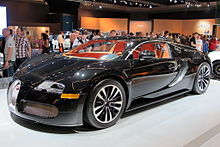
|
May 2008 | 12 units were made. | |
| Bugatti Veyron Bleu Centenaire[36] | 
|
March 2009 | 1 unit was made. | |
| Bugatti Veyron "Jean-Pierre Wimille"[37] | 
|
September 2009 | Named after French racing driver Jean-Pierre Wimille who was a factory driver for Bugatti in the 1930s. | |
| Bugatti Veyron "Achille Varzi" | September 2009 | Named after Italian racing driver Achille Varzi who raced for Bugatti in the early 1930s. | ||
| Bugatti Veyron "Malcolm Campbell" | September 2009 | Named after British racing driver Malcolm Campbell who raced for Bugatti in the late 1920s. | ||
| Bugatti Veyron "Hermann zu Leiningen" | 
|
September 2009 | Named after German racing driver Hermann zu Leiningen who raced for Bugatti in the early 1930s. |
Bugatti Veyron 16.4 Grand Sport (2009–2015)
The targa top version of the Bugatti Veyron EB 16.4, dubbed the Bugatti Veyron 16.4 Grand Sport, was unveiled at the 2008 Pebble Beach Concours d'Elegance.[38][39] It has extensive reinforcements to compensate for the lack of a standard roof[40] and small changes to the windshield and running lights. Two removable tops are included, the second a temporary arrangement fashioned after an umbrella. The top speed with the hardtop in place is the same as the standard coupé version, but with the roof removed is limited to 369 km/h (229 mph)—and to 130 km/h (81 mph) with the temporary soft roof. The Grand Sport edition was limited to 150 units, with the first 50 going exclusively to registered Bugatti customers. Production began in the second quarter of 2009.
Special editions
| Name | Picture | Release date | Release price | Notes |
|---|---|---|---|---|
| Bugatti Veyron 16.4 Grand Sport Sang Bleu[41] | 
|
August 2009[42] | One off model featuring a two tone blue carbon fiber and polished aluminum exterior. | |
| Bugatti Veyron 16.4 Grand Sport L'Or Blanc[43] | 
|
June 2011 | €1.65 million, excluding taxes and transport | Collaboration between Bugatti and the Royal Porcelain Factory in Berlin. Claimed to be the first car to feature real porcelain parts, with a thin porcelain layer coating the exterior, as well as porcelain inlays on the interior and on certain exterior pieces such as the fuel filler cap, badges, and wheel center caps. One made. |
| Bugatti Veyron 16.4 Grand Sport "Dubai Motor Show 2011" Special Edition[44] | 
|
November 2011 | €1.58 million, excluding taxes and transport | Introduced with a horizontal colour split with a bright yellow body framed in visible black carbon (including black-tinted wheels), seats in yellow-coloured leather upholstery with black stitching, middle console in black carbon, dashboard, steering wheel and gearshift made of black leather with yellow stitching.[45] The car was then shown again at the 2012 Qatar Motor Show. |
| Bugatti Veyron 16.4 Grand Sport "Dubai Motor Show 2011" Special Edition | November 2011 | €1.74 million, excluding taxes and transport | Presented in a two-tone horizontal colour split consisting of visible blue carbon, framed in polished, anodised aluminium. | |
| Bugatti Veyron 16.4 Grand Sport "Dubai Motor Show 2011" Special Edition | 
|
November 2011 | €1.74 million, excluding taxes and transport | Came in the newly developed green carbon fibre tone with polished aluminium. |
| Bugatti Veyron 16.4 Grand Sport Bernar Venet[46] | 
|
December 2012[47] | One off model painted by French conceptual artist Bernar Venet, with designs on the exterior and interior made up of technical equations used by Bugatti engineers during the making of the Veyron.[48] |
Bugatti Veyron 16.4 Super Sport, World Record Edition (2010–2011)
The Bugatti Veyron 16.4 Super Sport is a faster, more powerful version of the Bugatti Veyron 16.4. Production was limited to 48 units. The Super Sport has increased engine power output of 1,200 PS (882 kW; 1,183 hp) at 6,400 rpm and a maximum torque of 1,500 N⋅m (1,106 lb⋅ft) at 3,000–5,000 rpm and a revised aerodynamic package.[49] The Super Sport has been driven as fast as 431.072 km/h (267.856 mph), making it the fastest production road car in the world at the time of its introduction[4][50][51] although it is electronically limited to 415 km/h (258 mph) to protect the tyres from disintegrating.[49]
The Bugatti Veyron 16.4 Super Sport World Record Edition is a version of the Bugatti Veyron 16.4 Super Sport. It is limited to five units. It has an orange body detailing, orange wheels, and a special black exposed carbon body. The electronic limiter is also removed with this version.[52]
The model was unveiled in 2010 at The Quail, followed by the 2010 Monterey Historic Races at Laguna Seca, and the 2010 Pebble Beach Concours d'Elegance.[53]
Top Speed World Record
On 4 July 2010, James May, a television presenter on BBC Two's television show Top Gear, drove the Veyron Super Sport on Volkswagen's Ehra-Lessien (near Wolfsburg, Germany) high-speed test track at 417.61 km/h (259.49 mph). Later that day, Bugatti's official test driver Pierre Henri Raphanel drove the Super Sport version of the Veyron at the same track to establish the car's top speed. With representatives of the Guinness Book of Records and German Technical Inspection Agency (TÜV) on hand, Raphanel made passes around the big oval in both directions achieving an average maximum speed of 431.072 km/h (267.856 mph), thus taking back the title from the SSC Ultimate Aero TT as the fastest production vehicle of all time.[7] The 431.072 km/h (267.856 mph) mark was reached by averaging the Super Sport's two test runs, the first reaching 427.933 km/h (265.905 mph) and the second 434.211 km/h (269.806 mph).[54][55]
When the record was certified it was already well known to the public that the customer car would be electronically limited to 415 km/h (258 mph). Yet, after a query by the Sunday Times Guinness' PR director Jaime Strang was quoted on 5 April 2013: "As the car's speed limiter was deactivated, this modification was against the official guidelines. Consequently, the vehicle's record set at 431.072 km/h is no longer valid." On 10 April 2013, it was written on its website: "Guinness World Records would like to confirm that Bugatti's record has not been disqualified; the record category is currently under review."
On 15 April 2013, Bugatti's speed record was confirmed: "Following a thorough review conducted with a number of external experts, Guinness World Records is pleased to announce the confirmation of Bugatti's record of Fastest production car achieved by the Veyron 16.4 SuperSport. The focus of the review was with respect to what may constitute a modification to a car's standard specification. Having evaluated all the necessary information, Guinness World Records is now satisfied that a change to the speed limiter does not alter the fundamental design of the car or its engine."[56][57][58]
Bugatti Veyron 16.4 Grand Sport Vitesse (2012–2015)
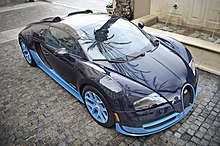
The Bugatti Veyron 16.4 Grand Sport Vitesse is a targa top version of the Veyron Super Sport. The engine in the Vitesse variant has a maximum power output of 1,200 PS (882 kW; 1,183 bhp) at 6,400 rpm and a maximum torque of 1,500 N⋅m (1,100 lb⋅ft) at 3,000–5,000 rpm. These figures allow the car to accelerate from a stand still to 100 km/h (62 mph) in 2.6 seconds. On normal roads, the Vitesse is electronically limited to 375 km/h (233 mph).
The Vitesse was first unveiled at the 2012 Geneva Motor Show[59][60] and later at the 2012 Beijing Auto Show[61] and the 2012 São Paulo Motor Show.[62]
Special editions
A number of special editions of the Vitesse were made:
- The World Record Car (WRC) Edition was limited to 8 units, debuted in 2013, and went on sale for €1.99 million.[63][64][65]
| Name | Picture | Release date | Release price | Notes |
|---|---|---|---|---|
| Bugatti Veyron 16.4 Grand Sport Vitesse Le Ciel Californien.[66][67][68][69] | 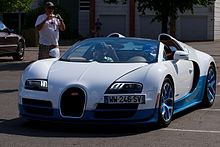
|
August 2012 | €1.74 million (US$2.2 million) | Inspired by the Bugatti Type 37A. |
| Bugatti Veyron 16.4 Grand Sport Vitesse "1 of 1"[70] | 18 August 2014 | Commissioned by a customer in Singapore. | ||
| Bugatti Veyron 16.4 Grand Sport Vitesse La Finale[71] | 
|
March 2015 | The final Veyron made, featuring a flipped version of the original Veyron's red and black color scheme, finished in red and black carbon fiber. |
In 2013, Bugatti produced a series of Vitesse dedicated to racing legends, including Jean-Pierre Wimille,[72][73] Jean Bugatti,[74][75] Meo Costantini,[76] and Ettore Bugatti.[77]

All six models in the Legend series are limited to three vehicles:[78]
| Name | Picture | Release date | Release price | Notes |
|---|---|---|---|---|
| Bugatti Legend "Jean-Pierre Wimille"[79] | 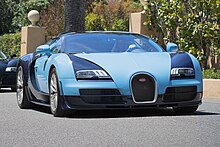
|
24 July 2013 | Pays homage to the 1937 Bugatti Type 57G Tank race car that factory driver Jean-Pierre Wimille won Bugatti's first 24 Hours of Le Mans victory in 1937.[80] | |
| Bugatti Legend "Jean Bugatti"[81] | 
|
9 September 2013 | €2.28 million, excluding taxes and transport | Named after Jean Bugatti, the eldest son of company founder Ettore. Inspired by the Bugatti Type 57SC Atlantic "La Voiture Noire", and features Bugatti's first use of platinum in the badges.[82] |
| Bugatti Legend "Meo Costantini"[83] | 
|
5 November 2013 | €2.09 million, excluding taxes and transport | This model is reminiscent of the Bugatti Type 35. One of the three model made, the only US-spec car, was sold in August 2020 at Bonhams Quail auction for US$1,750,000 inc. premium.[84] |
| Bugatti Legend "Rembrandt Bugatti"[85][86] | 
|
3 March 2014 | €2.18 million, excluding taxes and transport | Named after Rembrandt Bugatti, the brother of company founder Ettore and one of the most important sculptors of the 20th century. |
| "Black Bess" Legend Vitesse[87][88] | 
|
10 April 2014 | €2.15 million, excluding taxes and transport | This model pays homage to the famed Bugatti Type 18 "Black Bess". |
| Bugatti Legend "Ettore Bugatti"[89] | 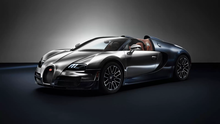
|
7 August 2014 | €2.35 million, excluding taxes and transport | This model harks back to the Bugatti Type 41 Royale. |
Records
A Bugatti Veyron 16.4 Grand Sport Vitesse driven by the Chinese racing driver Anthony Liu at Volkswagen Group's proving grounds in Ehra-Lessien became the fastest open-top production sports car, with a top speed of 408.84 km/h (254.04 mph).[64]
After the world record attempt, Dr. Wolfgang Schreiber, President of Bugatti Automobiles S.A.S, said "When we introduced the Vitesse, we established the top speed for open-top driving to be 375 km/h. Still, we could not let go of the idea of reaching the 400 km/h mark with this car as well. The fact that we have succeeded in reaching 408.84 km/h is a thrill for me, and it reaffirms once again that Bugatti is the leader when it comes to technology in the international automotive industry." The driver, Anthony Liu, claimed "Even at such high speeds it remained incredibly comfortable and stable. With an open-top, you can really experience the sound of the engine and yet even at higher speeds I did not get compromised by the wind at all."[63]
Specifications (all variants)
| Basic specifications[26][4] | |||
|---|---|---|---|
| Layout and body style | Mid-engine, four-wheel drive, two-door coupé/targa top | Base price | Standard (Coupé), Grand Sport (Roadster): €1,225,000 (£1,065,000; US$1,700,000) Super Sport (Coupé), Grand Sport Vitesse (Roadster): €1,912,500 (£1,665,000; US$2,700,000) |
| Internal combustion engine | 8.0 litre W16, 64v 2xDOHC quad-turbocharged petrol engine | Engine displacement and max. power |
7,993 cc (487.8 cu in) Standard (Coupé), Grand Sport (Roadster): 1,001 PS (736 kW; 987 bhp) at 6,000 rpm Super Sport (Coupé), Grand Sport Vitesse (Roadster): 1,200 PS (882 kW; 1,183 bhp) at 6,400 rpm |
| Performance | ||
|---|---|---|
| Standard, Grand Sport | Super Sport, Grand Sport Vitesse | |
| Top Speed | 408.47 km/h (253.81 mph)[90] | 431.072 km/h (267.856 mph); 415 km/h (258 mph) limited[55] |
| 0–100 km/h (62 mph) | 2.46 seconds[91][92] | |
| 0–200 km/h (124 mph) | 7.3 seconds[93][94] | 6.7 seconds[95][96] |
| 0–300 km/h (186 mph) | 16.7 seconds[93][94] | 14.6 seconds[95][96] |
| 0–400 km/h (249 mph) | 55.6 seconds[94] | 40 seconds (estimated)[97][98] |
| Standing quarter-mile (402 m) | 10.1 seconds[99] | 9.7 seconds[95] |
| Standing mile (1609 m) | 25.9 seconds at 328.9 km/h (204.4 mph)[100] | 23.6 seconds[95] |
| Braking from 100 km/h (62 mph) | 31.4 m[93][95] | |
| 0–300–0 km/h (0–186–0 mph) | 27.8 seconds[101] | 22.5 seconds[95] |
| 0–322–0 km/h (0–200–0 mph) | 25.6 seconds[95] | |
| Lateral acceleration | ? | 1.4 g[95] |
| Fuel economy[102] | |||
|---|---|---|---|
| EPA city driving | 8 miles per U.S. gallon (29 L/100 km; 9.6 mpg‑imp) | EPA highway driving | 14 miles per U.S. gallon (17 L/100 km; 17 mpg‑imp) |
| Top speed fuel economy | 3 miles per U.S. gallon (78 L/100 km; 3.6 mpg‑imp), or 1.4 U.S. gal (5.3 L; 1.2 imp gal) per minute | ||
Special editions by car tuners
Bugatti Veyron Linea Vincero
The Bugatti Veyron Linea Vincero is a Veyron 16.4 modified by the German car modification firm Mansory.[103]
The Linea Vincero has new wheel rims and new exterior lower bodywork. It extensively uses carbon fibre in the interior and exterior as well.
This car, with its interior and exterior customisations, is worth US$1 million more than a standard Veyron 16.4.[104]
Bugatti Veyron Linea D'oro
The Bugatti Veyron Linea D'oro is a car made on the basis of the Veyron Grand Sport and the 16.4 by the German car modification firm Mansory.
The D'oro's exterior design is identical to its predecessor's but it has a few differences such as the gold paint on the badge, rims and other features. The iconic V-shaped badge is also present on this car's front grille.[105]
Bugatti Veyron Linea Viviere

The Bugatti Veyron Linea Viviere (commonly known as the Mansory Viviere) is a car made on the basis of the Bugatti Veyron Super Sport by the German car modification firm Mansory.
This car's exterior design features the iconic V-shaped front grille and an additional exhaust system below its rear lights. The interior has been handcrafted and carbon fibre has been extensively used.[106]
This car has a second generation known as the Viviere Diamond Edition which has been made on the same basis. This car is the final Veyron Edition tuned by Mansory and has a marble coloured exterior paintwork.[107]
The Bugatti Veyron Linea Viviere costs US$2.3 million, making it one of the most expensive Veyrons ever produced.[108]
Production
As of 6 August 2014, 405 cars had been produced and delivered to customers worldwide, with orders that have already been placed for another 30. Bugatti was reported to produce 300 coupés and 150 roadsters up to the end of 2015.[109] Production amounted to 450 units in a span of over 10 years. The final production vehicle, a Grand Sport Vitesse titled "La Finale" (The Last One), was displayed at the Geneva Motor Show from 5–15 March 2015.[110]
| Name | Units made | |
|---|---|---|
| Veyron 16.4 | 252 | |
| Veyron Grand Sport | 58 | |
| Veyron Super Sport | 48 | |
| Veyron Grand Sport Vitesse | 92 | |
| Total | 450 | |
Future development
In 2008, Bugatti then-CEO Dr Franz-Josef Paefgen confirmed that the Veyron would be replaced by another high-end model by 2012.[111] In 2011, the new CEO Wolfgang Dürheimer revealed that the company was planning to produce two models in the future — one a sports car-successor to the Veyron, the other a limousine known as the Bugatti 16C Galibier, which was later cancelled since Bugatti was later then working on a successor to the Veyron, which became the Bugatti Chiron.[112]
The successor to the Veyron was unveiled in concept form as the Bugatti Vision Gran Turismo at the September 2015 Frankfurt Motor Show.
A toned-down version of the radically styled Vision Gran Turismo concept car, now called the Chiron, debuted at the March 2016 Geneva Motor Show. Production started in 2017 and will be limited to 500 units.
Sales
| Year | Units sold |
|---|---|
| 2005 | 5[113] |
| 2006 | 44[113] |
| 2007 | 81[114] |
| 2008 | 71[115] |
| 2009 | 50[115] |
| 2010 | 40[116] |
| 2011 | 38[117]1 |
| 2012 | 31[118] |
| 2013 | 47[119] |
| Total | 407 ISI |
- ^ The last Veyron, No. 450 was sold in May 2014.
Reception
Top Gear
All three former presenters of the popular BBC motoring show Top Gear have given the Veyron considerable praise. While initially skeptical that the Veyron would ever be produced, Jeremy Clarkson later declared the Veyron "the greatest car ever made and the greatest car we will ever see in our lifetime", comparing it to Concorde and S.S. Great Britain. He noted that the production cost of a Veyron was £5 million, but was sold to customers for just £1 million. Volkswagen designed the car merely as a technical exercise. James May described the Veyron as "our Concorde moment". Clarkson test drove the Veyron from Alba in northern Italy to London in a race against May and Richard Hammond who made the journey in a Cessna 182 aeroplane.
A few episodes later, May drove the Veyron at the VW test track and took it to its top speed of 407.16 km/h (253.00 mph). In series 10, Hammond raced the Veyron against the Eurofighter Typhoon and lost. He also raced the car in Series 13 against a McLaren F1 driven by The Stig in a one-mile (1.6 km) drag race in Abu Dhabi. The commentary focused on Bugatti's "amazing technical achievement" versus the "non-gizmo" racing purity of the F1. While the F1 was quicker off the line and remained ahead until both cars were travelling at approximately 200 km/h (124 mph), the Bugatti overtook its competitor from 200 to 300 km/h (124 to 186 mph) and emerged the victor. Hammond has stated that he did not use the Veyron's launch control in order to make the race more interesting.
The Veyron also won the award for "Car of the Decade" in Top Gear's end of 2010 award show. Clarkson commented, "It was a car that just rewrote the rule book really, an amazing piece of engineering, a genuine Concorde moment". When the standard version was tested in 2008, it did not reach the top of the lap time leader board, with a time of 1:18.3, which was speculated as being due to the car's considerable weight disadvantage against the other cars towards the top. In 2010 the Super Sport version achieved the fastest ever time of 1:16.8 (dethroned the Gumpert Apollo S, replaced by the Ariel Atom V8 in 2011),[120] as well as being taken to a verified average top speed of 431 km/h (268 mph) by Raphanel on the programme,[121] thenceforth retaking its position as the fastest production car in the world.[122][123][124]
Martin Roach
In 2011, Martin Roach's book Bugatti Veyron: A Quest for Perfection – The Story of the Greatest Car in the World[125] took the stance that the car had now become so famous that it is effectively a bona fide celebrity. The book follows its author as he attempts to track down and drive the car, along the way interviewing chief designers, test drivers, and the president of Bugatti.
Gordon Murray
During its development period McLaren F1 designer Gordon Murray said in UK auto magazine Evo: "The most pointless exercise on the planet has got to be this four-wheel-drive, thousand-horsepower Bugatti." But after driving it he called it "a huge achievement".[126]
Murray was impressed with the Veyron's engine and transmission after he test drove one for Road & Track magazine. He also praised its styling: "The styling is a wonderful mélange of classic curves and mechanical edges and elements — this should ensure that the car will still look good years from now, and therefore have a chance of becoming a future classic."[127]
See also
References
- ^ "Molsheim Experience". Bugatti. Retrieved 21 March 2020.
- ^ "Staff change at Škoda Auto design department" (Press release). Škoda-Auto.com. 10 December 2007. Archived from the original on 8 October 2008. Retrieved 29 August 2009.
Jozef Kabaň . . . Commissioned by the Volkswagen Group, he became responsible for developing the design of the Bugatti Veyron in 1999, and then worked in that position from the time of the first sketches until the point of launching mass production.
- ^ "Veyron 16.4". Archived from the original on 13 July 2016. Retrieved 1 June 2017.
- ^ a b c "Bugatti Veyron 16.4 Super Sport Pictures". DieselStation. 5 July 2010. Retrieved 6 July 2010.
- ^ "Veyron 16.4". Bugatti. Archived from the original on 4 March 2016.
- ^ a b c "400 and Beyond". bugatti.com. 19 April 2005. Archived from the original on 2 September 2011. Retrieved 28 April 2018.
- ^ a b "SpeedTV: Super Bugatti shatters speed record". Automotive.speedtv.com. 5 July 2010. Archived from the original on 14 June 2013. Retrieved 9 April 2012.
- ^ "Bugatti Veyron Grand Sport Vitesse WRC (2013) – page 2". Net Car Show. Retrieved 30 April 2013.
- ^ "Bugatti Veyron Grand Sport Vitesse World Record Car Edition officially announced". World Car Fans. Retrieved 11 April 2013.
- ^ Duff, Mike (8 September 2019). "Bugatti Launches Limited Chiron Super Sport 300+, World's Fastest Production Car". Car & Driver. Archived from the original on 4 October 2019. Retrieved 8 September 2019.
- ^ "Burmester Audiosysteme & Bugatti". Burmester Audiosysteme. Retrieved 20 September 2018.
- ^ "Bugatti.com – Veyron 16.4 Configurator". Bugatti.com. Archived from the original on 30 December 2010. Retrieved 21 December 2010.
- ^ "Bugatti Veyron Configurator Goes Online". AutoEvolution.com. 15 December 2010. Retrieved 21 December 2010.
- ^ "Bugatti presents three more studies". Archived from the original on 6 August 2017. Retrieved 25 October 2019.
- ^ "France's Most Revered Marque Is Born Again". 2 January 2002.
- ^ "Bugatti presents the Veyron 16.4. The only one of these concept vehicles to really hit. study". Archived from the original on 6 August 2017. Retrieved 25 October 2019.
- ^ Filipponio, Frank (6 January 2010). "Walter de'Silva's forgotten 1999 Bugatti Concept". Autoblog. Retrieved 9 February 2024.
- ^ "Bugatti 16/4 Veyron Preproduction". Archived from the original on 22 February 2013. Retrieved 24 August 2012.
- ^ "Pierre Veyron". bugatti.com. Bugatti Automobiles S.A.S. 30 November 2011. Archived from the original on 2 June 2012. Retrieved 28 July 2012.
The zenith of Veyron's racing career was his victory together with Jean Pierre Wimille in the 25-hour Le Mans race of 1939.
- ^ "Bugatti Veyron 16.4 Review". Edmunds.com. Retrieved 9 July 2011.
- ^ a b c Phillips, John (December 2008). "Bugatti Veyron 16.4 – Road Test". Car and Driver. Archived from the original on 3 June 2009. Retrieved 22 October 2011.
- ^ "Lightweight Construction Concept". bugatti.com. 30 November 2011. Archived from the original on 21 April 2012. Retrieved 9 April 2012.
- ^ a b c d e Adams, Eric (2006). "Inside a Street-Legal Land Rocket". Popular Science. 269 (6): 73.
- ^ "the Bugatti Page: Bugatti Veyron driving experience". Bugattipage.com. Retrieved 27 October 2008.
- ^ "Telegraph | Picture Gallery | BUGATTI VEYRON". The Daily Telegraph. UK. 10 September 2008. Archived from the original on 21 May 2008. Retrieved 27 October 2008.
- ^ a b Csere, Csaba (November 2005). "Bugatti Veyron 16.4 – First Drive Review: The fastest and most expensive production car currently". Car and Driver.
When I ask Bugatti development boss Wolfgang Schreiber to explain how the same engine can be rated at 1 SAE net horsepower at 6000 rpm for the U.S. but only 987 horsepower (1001 PS) for Europe, he laughs, saying, "The production engines are all putting out between 1020 and 1040 PS—enough to cover both promises."
- ^ "Bugatti Veyron 16.4" (PDF). Car and Driver. Archived from the original (PDF) on 18 April 2013.
- ^ "2.5 – 7.3 – 16.7 – 55.6". Bugatti.com.
- ^ "Top Gear : James May's Bugatti Veyron Top Speed Test – Top Gear – BBC autos". Top Gear. 16 December 2008. Archived from the original on 2 November 2021. Retrieved 5 August 2013.
- ^ "Driving Innovations for Sustainable Mobility" (PDF). United Nations Economic Commission for Europe. February 2016. Retrieved 30 January 2019.
- ^ "Pur Sang - Bugatti Editions - Models". www.bugatti.com. Retrieved 23 August 2019.
- ^ Communications, Bugatti (12 October 2023). "The intricate savoir-faire in carbon fiber at Bugatti – Bugatti Newsroom". newsroom.bugatti.com. Retrieved 4 January 2024.
- ^ "FBG par Hermès - Bugatti Editions - Models". www.bugatti.com. Retrieved 23 August 2019.
- ^ "Geneva 2008: Bugatti Veyron Fbg by Hermes, scepter and empire not included". Autoblog. 4 March 2008. Retrieved 23 August 2019.
- ^ "Sang Noir - Bugatti Editions - Models". www.bugatti.com. Retrieved 23 August 2019.
- ^ "Bleu Centenaire - Bugatti Editions - Models". www.bugatti.com. Retrieved 23 August 2019.
- ^ "Villa D'Este - Bugatti Editions - Models". www.bugatti.com. Retrieved 23 August 2019.
- ^ "Bugatti Veyron Grand Sport debuts at Pebble Beach Concours d'Elegance". LeftLaneNews.com. 18 August 2008. Retrieved 29 August 2009.
- ^ Lavrinc, Damon (16 August 2008). "Monterey 2008: Bugatti Veyron 16.4 Grand Sport". Autoblog. Retrieved 4 December 2013.
- ^ "First Drive: Bugatti Veyron 16.4 Grand Sport is a temple of Zen". AutoBlog.com. 7 July 2009. Retrieved 29 August 2009.
- ^ "Sang Bleu - Bugatti Editions - Models". www.bugatti.com. Retrieved 23 August 2019.
- ^ "Bugatti Veyron Grand Sport". Autoblog. 14 August 2009. Retrieved 23 August 2019.
- ^ "L'Or Blanc - Bugatti Editions - Models". www.bugatti.com. Retrieved 23 August 2019.
- ^ "Bugatti brings three special Veyron Grand Sports to Dubai". Autoblog. 10 November 2011. Retrieved 23 August 2019.
- ^ Joseph, Noah (24 January 2012). "Bugatti showcases the Bumblebee of Veyrons in Qatar". Autoblog. Retrieved 4 December 2013.
- ^ "Bernar Venet - Bugatti Editions - Models". www.bugatti.com. Retrieved 23 August 2019.
- ^ "Bugatti by Venet is the world's fastest art". Autoblog. 7 December 2012. Retrieved 23 August 2019.
- ^ Ayapana, Erick. "Bugatti Veyron Grand Sport Art Car is a Math Geek's Dream Come True".
- ^ a b "Car News and reviews, videos, wallpapers, pictures, free games and more. – Top Speed :: 2011 Bugatti Veyron 1640 Super Sport". 5 July 2010. Retrieved 8 August 2010.
- ^ "Bugatti Veyron 16.4 Super Sport sets land speed record at 267.81 mph!". Autoblog. 5 July 2010. Retrieved 5 July 2010.
- ^ "Bugatti Veyron 16.4 Super Sport breaks landspeed worldrecord!". Used Cars Centre. 5 July 2010. Archived from the original on 10 July 2010. Retrieved 5 July 2010.
- ^ "World Record Edition". Bugatti. Archived from the original on 6 January 2014. Retrieved 6 January 2014.
- ^ "Bugatti Veyron Super Sport World Record Edition limited to 10 mph less than world record". World Car Fans. 17 October 2010. Retrieved 6 January 2014.
- ^ "NEW CAR NET, the UK new car guide :: Bugatti news – Veyron re-takes land speed record". 2010 Netro42. Retrieved 9 July 2010.
- ^ a b "Bugatti Veyron Super Sport: Aerodynamischer Weltrekordler". manager magazin. 9 July 2010. Retrieved 19 December 2018.
- ^ "And the world's fastest car is ... the Bugatti Veyron Super Sport (again)". newatlas.com. 16 April 2013. Retrieved 19 December 2018.
- ^ Wilkinson, Leo (15 April 2013). "Bugatti Veyron gets its 'fastest car' title reinstated". The Daily Telegraph. London. Archived from the original on 12 January 2022.
- ^ "Guinness World Records statement: Fastest Production Car". Guinness World Records. 12 April 2013. Retrieved 13 May 2013.
- ^ Noah Joseph (22 February 2012). "Bugatti presents new Veyron Grand Sport Vitesse for Geneva debut". Autoblog.com. Retrieved 9 April 2012.
- ^ "2012 Bugatti Veyron Grand Sport Vitesse". Top Speed. 22 February 2012. Retrieved 3 November 2012.
- ^ "Bugatti Veyron 16.4 Grand Sport Vitesse at the Beijing Auto Show". carnewschina.com. 28 April 2012.
- ^ Miersma, Seyth (23 October 2012). "Bugatti brings Veyron Grand Sport Vitesse "Gris Rafale" to Brazil". Autoblog. Retrieved 4 December 2013.
- ^ a b "Bugatti Veyron Grand Sport Vitesse becomes the fastest convertible in the world". Yahoo Autos. 11 April 2013.
- ^ a b John Neff (11 April 2013). "Bugatti Veyron Grand Sport Vitesse sets world record for fastest open-top car". Autoblog. Retrieved 24 January 2015.
- ^ zweipol GmbH. "bugatti.com – News". bugatti.com. Archived from the original on 3 December 2013.
- ^ Bowman, Zach (18 August 2012). "Bugatti Veyron 16.4 Grand Sport Vitesse is the same Bug with new paint". Autoblog. Retrieved 4 December 2013.
- ^ Harley, Michael (22 August 2012). "Special Edition Bugatti Veyron 16.4 Grand Sport Vitesse sells for $2.5 million". Autoblog. Retrieved 4 December 2013.
- ^ "Bugatti Veyron 16.4 Grand Sport Vitesse SE debuts at Pebble Beach". Worldcarfans.com. Retrieved 3 November 2012.
- ^ "2013 Bugatti Veyron 16.4 Grand Sport Vitesse 'Le Ciel Californien' | Monterey 2014". RM Sotheby's. Retrieved 24 August 2021.
- ^ "Bugatti surprises with Vitesse 1 of 1 edition". Autoblog. 22 August 2014. Retrieved 23 August 2019.
- ^ "Bugatti Veyron bids adieu with the Grand Sport Vitesse La Finale [w/video]". Autoblog. 2 March 2015. Retrieved 23 August 2019.
- ^ Damon Lowney (24 July 2013). "Bugatti to debut special Grand Sport Vitesse 'Legend Jean-Pierre Wimille' during Monterey Car Week [UPDATE]". Autoblog.
- ^ Brandon Turkus (16 August 2013). "Bugatti debuts first Veyron Legends model in Pebble Beach". Autoblog.
- ^ Brandon Turkus (9 September 2013). "Bugatti Veyron Legend 'Jean Bugatti' bows ahead of Frankfurt reveal". Autoblog.
- ^ Steven J. Ewing (11 September 2013). "Bugatti Veyron Grand Sport Vitesse 'Jean Bugatti' recalls La Voiture Noire". Autoblog.
- ^ Noah Joseph (5 November 2013). "Bugatti's third Legend edition Veyron pays tribute to Meo Costantini". Autoblog.
- ^ Noah Joseph (7 August 2014). "Final Legend edition Veyron dedicated to Ettore Bugatti". Autoblog.
- ^ "Les Légendes de Bugatti - Bugatti Editions". www.bugatti.com. Retrieved 23 August 2019.
- ^ "Jean-Pierre Wimille - Bugatti Editions - Models". www.bugatti.com. Retrieved 23 August 2019.
- ^ Russell, Sean. "3 Bugatti Veyron "Jean-Pierre Wimille" Legends Edition Released". Motor Trend.
- ^ "Jean Bugatti - Bugatti Editions - Models". www.bugatti.com. Retrieved 23 August 2019.
- ^ McCausland, Evan. "2013 Bugatti Veyron Jean Bugatti Legend Edition First Look". Motor Trend.
- ^ "Meo Constantini - Bugatti Editions - Models". www.bugatti.com. Retrieved 23 August 2019.
- ^ "Bonhams : 2014 Bugatti VEYRON 16.4 GRAND SPORT VITESSE 'MEO COSTANTINI'". www.bonhams.com. Retrieved 8 March 2021.
- ^ "Bugatti Legends series welcomes brother Rembrandt". Autoblog. 3 March 2014. Retrieved 23 August 2019.
- ^ "Rembrandt Bugatti - Bugatti Editions - Models". www.bugatti.com. Retrieved 23 August 2019.
- ^ "Bugatti reveals Black Bess as fifth Legend edition Veyron". Autoblog. 11 April 2014. Retrieved 23 August 2019.
- ^ "Black Bess - Bugatti Editions - Models". www.bugatti.com. Retrieved 23 August 2019.
- ^ "Ettore Bugatti". www.bugatti.com. Retrieved 24 March 2023.
- ^ "400 and Beyond". Archived from the original on 11 October 2007. Retrieved 25 February 2011.
- ^ "Bugatti Veyron EB 16.4 - Motor Museum". National Motor Museum. Retrieved 19 December 2018.
- ^ "Kidston - Sold Cars". www.kidston.com. Retrieved 19 December 2018.
- ^ a b c "Bugatti Veyron 16.4: Technical Specifications" (PDF). Bugatti. Archived from the original (PDF) on 27 April 2018. Retrieved 26 April 2018.
- ^ a b c "Veyron Acceleration: 2.5 – 7.3 – 16.7 – 55.6". Archived from the original on 7 February 2015.
- ^ a b c d e f g h "Archived copy" (PDF). Archived from the original (PDF) on 22 August 2017. Retrieved 23 December 2017.
{{cite web}}: CS1 maint: archived copy as title (link) - ^ a b "bugatti.com – The climax of the Veyron series:the Bugatti Veyron 16.4 Super Sport". Archived from the original on 28 September 2014. Retrieved 30 September 2014.
- ^ Yus, Victor Alós (12 September 2017). "Bugatti Chiron: from 0 to 400 km/h and back to stop in just over 40 seconds". Highmotor. Retrieved 24 November 2024.
- ^ Vijayenthiran, Viknesh (2 June 2014). "More Transformers 4 Cars Revealed In New Television Spots: Video". Yahoo Autos. Retrieved 24 November 2024.
- ^ Phillips, John (1 December 2008). "Bugatti Veyron 16.4". Car and Driver.
- ^ Andrew Bornhop (27 July 2007). "Speed Kings: Bugatti Veyron 16.4". Road & Track. Retrieved 19 December 2018.
- ^ "Bugatti Veyron 16.4 im Beschleunigungs- und Bremsentest 0-300-0 km/h". auto-motor-und-sport.de (in German). 9 September 2010. Retrieved 4 December 2020.
- ^ "Gas mileage of 2006 Bugatti Veyron". Fueleconomy.gov. Retrieved 9 April 2012.
- ^ "Linea Vincero". Mansory. 16 April 2019. Retrieved 30 July 2021.
- ^ Kelshikar, Tushar (18 April 2017). "Manny Khoshbin's Bugatti Veyron Mansory Linea Vincero For Sale". The Supercar Blog. Retrieved 30 July 2021.
- ^ "Linea d'Oro". Mansory. 26 April 2019. Retrieved 31 July 2021.
- ^ "Linea Vivere". Mansory. 16 April 2019. Retrieved 31 July 2021.
- ^ "Vivere Diamond Edition". Mansory. 16 April 2019. Retrieved 31 July 2021.
- ^ Perez, Jeff. "Watch This $2.3M Bugatti Do The World's Most Expensive Burnout". Motor1.com. US. Retrieved 31 July 2021.
- ^ Greg Kable. "Bugatti Veyron production nears end". autocar.co.uk.
- ^ "Last ever Bugatti Veyron to appear at Geneva Motor Show – the £1.5 million supercar has ceased production". Mirror UK. Retrieved 18 February 2015.
- ^ "Bugatti plans Veyron replacement". Autocar. 2008. Retrieved 29 April 2013.
- ^ Pollard, Tom (18 April 2011). "Bugatti Galibier 'will be a hybrid' – Wolfgang Durheimer". Car Magazine Online. Retrieved 29 April 2013.
- ^ a b "Annual Report 2006" (PDF). Volkswagen AG. 9 March 2007. p. 43. Archived from the original (PDF) on 17 July 2011. Retrieved 27 September 2011.
- ^ "Annual Report 2008" (PDF). Volkswagen AG. 12 March 2009. p. 121. Archived from the original (PDF) on 1 October 2011. Retrieved 27 September 2011.
- ^ a b "Annual Report 2009" (PDF). Volkswagen AG. 11 March 2010. Archived from the original (PDF) on 17 July 2011. Retrieved 27 September 2011.
- ^ [1] Archived 17 July 2011 at the Wayback Machine
- ^ "Volkswagen AG Annual Report 2011" (PDF). Volkswagen AG Annual Report 2011: 161. Archived from the original (PDF) on 26 May 2012. Retrieved 13 October 2012.
- ^ "Bugatti 2012 sales figures" (PDF). Archived from the original (PDF) on 1 February 2014.
- ^ "Annual Report 2013" (PDF). Volkswagen AG. 13 March 2014. p. 80. Archived from the original (PDF) on 14 March 2014. Retrieved 14 March 2014.
- ^ "Power Laps". Top Gear UK. BBC. Retrieved 29 November 2011.
- ^ Hudson, Paul (18 October 2010). "Bugatti Veyron 16.4 SuperSport review". The Daily Telegraph. UK. Archived from the original on 12 January 2022. Retrieved 1 November 2010.
The Bugatti Veyron Super Sport is officially the world's fastest production car, after reaching 431.072 km/h (267.856 mph) at the VW group's Ehra-Lessien test track on 3 July. Watched by independent testers and a Guinness Book of Records representative, Bugatti test driver Pierre-Henri Raphanel recorded two runs in opposite directions, reaching 427.933 km/h (265.905 mph) and 434.211 km/h (269.806 mph) respectively. The new record is an average of the two.
- ^ "Bugatti Veyron 16.4 Super Sport sets land speed record at 267.81 mph!". autoblog.com. 4 July 2010. Retrieved 4 July 2010.
- ^ "Veyron SuperSport hits 267mph". topgear.com. Archived from the original on 12 May 2015. Retrieved 6 July 2010.
- ^ "Bugatti SuperSport speed test – Top Gear – BBC". Top Gear. 24 July 2010. Archived from the original on 2 November 2021. Retrieved 25 January 2011.
- ^ Roach, Martin (29 September 2011). Bugatti Veyron: A Quest for Perfection – The Story of the Greatest Car in the World. Preface Publishing. ISBN 978-1-84809-348-5.
- ^ Wilkinson, Stephan (16 March 2009). "Selling the Bugatti Veyron". Forbes. Retrieved 18 April 2013.
- ^ "Technical Analysis: Anatomy of a Supercar (1/2006)". Road & Track. Archived from the original on 5 August 2010. Retrieved 27 October 2008.
External links
![]() Media related to Bugatti Veyron at Wikimedia Commons
Media related to Bugatti Veyron at Wikimedia Commons








